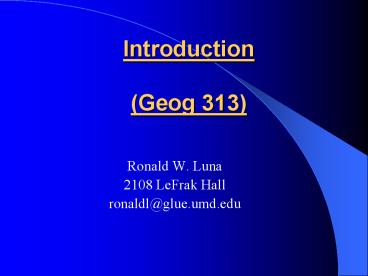Introduction Geog 313 - PowerPoint PPT Presentation
1 / 18
Title:
Introduction Geog 313
Description:
... transforms the natural environment creating humanized forms from stretches of ... original sense of creating the people and raw materials which social forces ' ... – PowerPoint PPT presentation
Number of Views:59
Avg rating:3.0/5.0
Title: Introduction Geog 313
1
Introduction(Geog 313)
- Ronald W. Luna
- 2108 LeFrak Hall
- ronaldl_at_glue.umd.edu
2
What is Geography?
3
What is Geography?
- Is an interdisciplinary field that uses space
and scale in order to understand complex issues.
Karna Couch - Takes into account physical and human
characteristics of the landscape. Sara Varsa - Studies the relationship between human and the
environment. Dr. Geores
4
What is Geography?
A definition of geography from Peet
(1998) Geography is the study of relations
between the society and the natural environment.
Geography looks at how society shapes alters and
increasingly transforms the natural environment
creating humanized forms from stretches of
pristine nature and then sedimenting layers of
socialization one within the other, one on top of
the other until a complex natural-social
landscape results. Geography also looks at how
nature conditions society, in some original sense
of creating the people and raw materials which
social forces work up into culture and in an
ongoing sense of placing limits and offering
material potentials for social processes like
economic development. Thus the synthetic core
of geography is the study of nature-society
interrelationships.
5
What is Geography?
- Spatial Science examines how, why, and where
interaction between humans and the environment
occurs.
6
What is Geography?
- Geography means the study of the earth.
- Studies natural or human phenomena through
space, scale, and time.
Natural Phenomenon
7
Space
- Geography is the science of space and place
(Location) - -Relative location
- -Absolute location
- Space- When we discuss space (cf. place) often
concerned with movement through space (distance
and time). - Place- For place the central issue is difference
relative to other places (relationship). - Questions that Geographers ask include
- -Where are things located and why are they there?
- -How are people and their activity distributed in
space? - -How do people perceive space?
- -How do people create places?
- -How and why are places different?
8
Scale
- Geographic scale is the dimension of how we
examine a physical or human phenomena. - Different social and physical processes operate
at different scales. - -Global (macro)
- -Region
- -Nation or State
- -Community, county, city, etc. (micro)
- Many processes interact across various scales.
9
Time
- Temporal scale- The historian has no exclusive
right in the telling of stories in time. But the
historian hopes to bring a special understanding
to such story-telling. - Equally the geographer can claim no exclusive
right to the telling of space stories, space
futures and space legends. - But the geographer should hope to tell such
stories with special insight. - -Compare two different places at a specific
period. - -Compare a place through history.
- -Why two cities have evolved differently over
time.
10
Tools
- Remote sensing
Cairo
San Francisco
11
Washington D.C. (1 meter)
Washington Monument
12
Tools
- Geographic Information System
13
Tools
- Cartography
14
Disciplines in Geography
- Physical Geography- is concerned primarily with
the physical processes and the relationship
between humans and the physical environment. Ex.
geomorphology, climatology, ecology, biology,
etc. - Technique- Cartography, Remote Sensing, and
Geographic Information System. - Human Geography
15
Human Geography
- Studies the spatial analysis of human population,
their culture, and activities. - Examines patterns, distribution, interaction, and
location of human phenomenon. - Observes the relationship between physical
environment and humans how we respond to change,
and interact with the physical world. - It is sometime referred as cultural or social
geography, although these terms usually refer to
sub-fields.
16
Natural Phenomenon
Hurricane Mitch on October 27, 1998
17
Interaction between Human and Physical Environment
- Physical features
- Winds measuring 150 miles per hour for eight
days and dropped 50 inches of rain in some areas
devastating the Caribbean coast of
CentralAmerica.
- Human affect
- -10 billion in total damages,
- -9,000 deaths,
- -10,000 missing,
- -millions displaced,
- -thousand emigrated.
- (Hunt, 1999, p. A7)
18
Human Geography
Sub-fields
Other fields
- Cultural Geography
- Population Geography
- Political Geography
- Urban Geography
- Economic Geography
- Medical Geography
- Historical Geography
- Social Geography
- Anthropology
- Demography
- Political Science
- Urban Studies
- Economics
- Medicine and Health
- History
- Sociology































